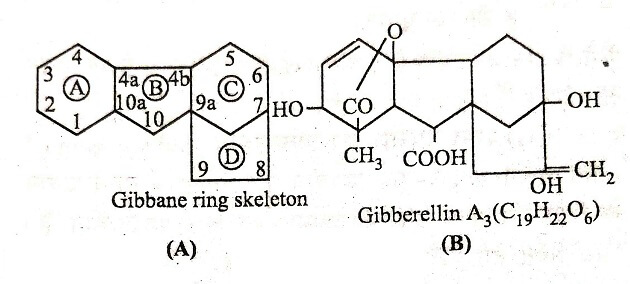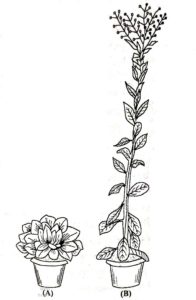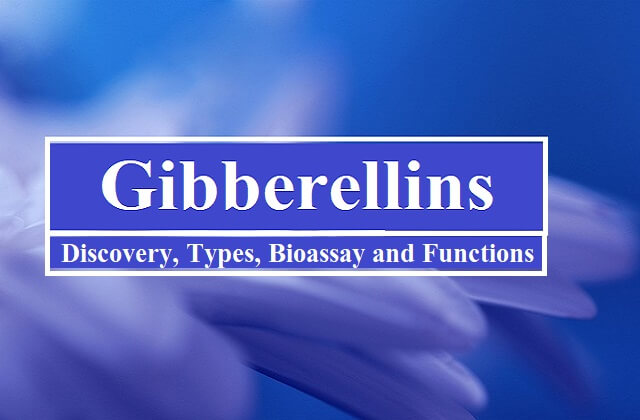Gibberellins are weakly acidic hormones which cause elongation of intact plant. Gibberellins increase the length of genetically dwarfed plants. Gibberellins Have Gibbane ring in its structure.

Discovery of Gibberellins
Kurosawa first isolated gibberellins from the fungus named Gibberella fujikuroi (Fusarium moniliforme) in 1926. Gibberella fujikuroi is the causal organism of Bakanae disease.
Yabuta, Sumiki and co-workers isolated inactive substance from the fungus in 1939. They belong to Japan. They used the term “Gibberellin” food their isolated substance.
“Gibberellins A3” was first pure obtained gibberellins.
The detailed structure of gibberellin was explained by Cross et al. In 1961.
At present 60 types of gibberellins have been identified from a different group of plants.
Gibberella fujikuroi has approx 15 types of gibberellins. Gibbane skeleton different types of among all the Gibberellins.
Gibberellins production is still carried out by culturing Gibberella fujikuroi fungus in large Vats.
Bioassay of gibberellins
Bioassay of gibberellins is performed through Maize plant. Pea plant is also used to perform bioassay of gibberellins.
Functions of gibberellins

- Stem Elongation- Growth is primarily controlled by gibberellins because the gibberellins induce cell elongation of the internodes of the stem. cell elongation of stem results due to Rapid cell division.
- Leaf expansion- when some plants treated with gibberellin lips become broader and elongated. Broader leaves have a photosynthetic area which finally increases the height of the plant. gibberellins show no effect on roots.
- Reversal of dwarfism- this is the most striking effect of gibberellins. gibberellins elongate the genetic dwarf varieties of plants such as corn and pea. It is believed that in the dwarf plants, dwarfism is due to blocking of the capacity for the normal gibberellin formation. This Blockage causes deficiency of gibberellins in those plants.
- Bolting- plants which are having rosette pattern of growth such as cabbage, henbane etc show remarkable growth after-treatment of the gibberellins. Gibberellins induce stem elongation in these types of plants. The effect is called bolting effect.
- Flowering- gibberellins initiate the flowering in plants. gibberellins are also helpful in the germination of cereals seeds.
- Enzyme formation- gibberellins induce the formation of hydrolytic enzymes in the aleurone layer of the endosperm of germinating Barley seeds. gibberellins also stimulate the production of digestive enzymes. Protease, alpha-amylase, lipase are digestive enzymes. gibberellins also stimulate a substantial synthesis of new mRNA.
- Breaking of dormancy- Gibberellins breaks the natural dormancy of seeds, tubers, Buds. Gibberellins allow them to grow fast. Due to the treatment of gibberellins sprouting of potato in cold storage occurs.
- Parthenocarpy- Gibberellins induces parthenocarpy in fruits such as apple, tomato and pear. The effect of gibberellins to induce parthenocarpy is more than auxins. Seedless grapes are also produced after-treatment of the brilliance.

- Sex Expression- Gibberellins promote the formation of male flowers weather in place of female flowers in monoecious plants or in genetically female plants.
In cucurbits, Gibberellins promote the formation of the male flower in place of the female flower. - Substitution for vernalization- vernalization required low temperature for certain plants. The requirement of low temperature in biennial flooring can be replaced by Gibberellins.
- Malt yield- when we provide gibberellins to germinating Barley grains remarkable malt production noticed.
- Delayed ripening of fruits- gibberellins delayed ripening of citrus fruits. It is useful for safe and prolonged storage of fruits.
- Seed germination- Gibberellins induce seed germination in lettuce and tobacco in complete darkness.
Biosynthesis of Gibberellins
In higher plants, the methylerythritol phosphate (MEP) pathway is the mechanism to gibberellins. bioactive GA is produced from trans-geranylgeranyl diphosphate (GGDP) in this pathway.
There are three classes of enzymes which are used to synthesize GA from GGDP in the MEP pathway.
1) terpene synthases (TPSs),
2) cytochrome P450 monooxygenases (P450s), and
3) 2-oxoglutarate–dependent dioxygenases (2ODDs)
Read Also-
- Cytokinins: Overview, Discovery, Types, Bioassay And Functions
- Abscisic Acid (ABA): Overview, Discovery, Types, Bioassay, Functions
- Factors Affecting Plant Growth: External Factors And Internal Factors
- Plant Hormones: Growth Regulators – Promoters And Inhibitors In Details
- Plant diseases: Symptoms, types, etc
Where are Gibberellins located?
Most of the bioactive GAs are located in actively growing organs of plants
What is the function of gibberellins?
These are main function of gibberellins: Stem Elongation, Leaf expansion, Reversal of dwarfism, Bolting effect, initiate the flowering, induces the formation of hydrolytic enzymes, breaks the natural dormancy of seeds, tubers, Buds, induces parthenocarpy in fruits, promote the formation of male flowers, induces seed germination
Who discovered gibberellins?
Kurosawa first isolated gibberellins from the fungus named Gibberella fujikuroi (Fusarium moniliforme) in 1926. Gibberella fujikuroi is the causal organism of Bakanae disease.
Here we have discussed “Gibberellins: Overview, Discovery, Types, Bioassay and Functions” we hope you like this article. if you have any query or suggestion, please leave a comment on the email. or contact us from contact us page.
Follow our official groups on Telegram, Whatsapp and Facebook

